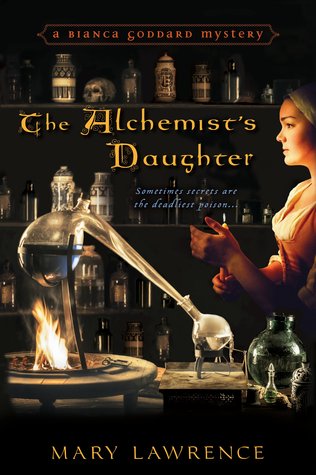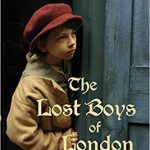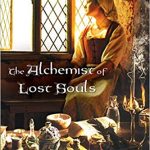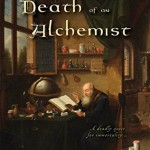 The Alchemist's Daughter (Bianca Goddard Mysteries #1) by Mary Lawrence
The Alchemist's Daughter (Bianca Goddard Mysteries #1) by Mary Lawrence Formats available: paperback, ebook
Series: Bianca Goddard #1
Pages: 304
Published by Kensington on April 28th 2015
Purchasing Info: Author's Website, Publisher's Website, Amazon, Barnes & Noble, Kobo, Bookshop.org
Goodreads
“A realistic evocation of 16th century London’s underside. The various strands of the plot are so skillfully plaited together.” —Fiona Buckley
In the year 1543 of King Henry VIII’s turbulent reign, the daughter of a notorious alchemist finds herself suspected of cold-blooded murder…
Bianca Goddard employs her knowledge of herbs and medicinal plants to concoct remedies for the disease-riddled poor in London’s squalid Southwark slum. But when her friend Jolyn comes to her complaining of severe stomach pains, Bianca’s prescription seems to kill her on the spot. Recovering from her shock, Bianca suspects Jolyn may have been poisoned before coming to her—but the local constable is not so easily convinced.
To clear her name and keep her neck free of the gallows, Bianca must apply her knowledge of the healing arts to deduce exactly how her friend was murdered and by whom—before she herself falls victim to a similar fate…
“Unique characters, a twisty plot and a bold, bright heroine add up to a great debut for Mary Lawrence’s The Alchemist’s Daughter. Mystery and Tudor fans alike will raise a glass to this new series.” —Karen Harper, author of
The Poyson Garden
My Review:
Think of The Alchemist’s Daughter as an antidote for all those Renaissance Faires where they make the English Renaissance look festive and clean, tidy and with no bad smells. With Bianca Goddard, we get a perspective on life among the ‘groundlings’, probably short, frequently nasty, and always unfair.
Bianca herself is an absolutely fascinating character, but the world she lives in is not a place any of us would want to visit, not even for an afternoon. The past, as they say, is another country, and they do things differently there.
Also it stinks.
Bianca has an interesting backstory. Her father is an alchemist. In other words, he was one of the the many would-be chemists who believed that there was a ‘philosopher’s stone’ that would turn lead and other base metals into gold. Trying to turn lead into gold, while fruitless, is also harmless. But Bianca’s obsessed father was also a Catholic during the latter part of Henry VIII’s reign, and nearly got executed after being caught up in a plan to overthrow the King. Someone accused him of attempting to poison Old King Hal, and he would have swung for it – if his daughter hadn’t proved his innocence – at least of that crime. (I hope the author gives us the full tale at some point in this series because it sounds amazing.)
But the notoriety brought both Bianca and her father to the attention of some of the powers that be, especially the conniving little ones who have just enough power to make life miserable for common people, which Bianca and her family certainly are.
Bianca is also unusual in that she has chosen to live apart from her family. Her father’s involvement in treasonous plots was the last straw for the independent minded Bianca. She wants to practice chemistry, not alchemy, and use the skills she learned at her father’s knee to find cures for the diseases that make people’s lives so short and miserable. Bianca lives alone in the tiny shack, or ‘rent’ that she, well, rents to practice her art.
Which makes her an all too easy target when her best friend comes to her in distress, and dies right there in Bianca’s arms. It was all too common for whoever was present at a death to be accused (and convicted) of it, and when her friend’s blood is found to be purple instead of red, accusations of poisoning fly at Bianca quicker than you can say “plague”.
The story in this book is Bianca dodging the inept law while trying to determine who really killed her friend. Because unless Bianca can find the real killer, she is the one who will be tortured and executed for the crime that she certainly did not commit.
Escape Rating A-: One of the things I found fascinating about this story is that is bookends the story of Lucie Wilton in Candace Robb’s Owen Archer series. Lucie is a master apothecary in York in the late 1300’s, and is also accused of murder. But so many things about the two women in these stories is a kind of mirror image. Lucie’s story takes place in the years before the Wars of the Roses, and Bianca’s take place in the aftermath two centuries later. Lucie is an acknowledged master of her craft, she owns her own shop and takes her own apprentices. Bianca is barely surviving, and is just as often called “witch” as “healer”. Also, Lucie marries Owen, where in Bianca’s first story, she steadfastly refuses to marry her long-time suitor, John. And Bianca’s reasons are lived out in Lucie. Bianca needs the freedom to devote herself to her obsession with her craft, where Lucie, who gets pregnant and has children and devastating miscarriages, is forced to divide her time between her life as a married woman running a household and her livelihood. Lucie never has the time, or frankly the inclination, for the kind of death-defying experiments that Bianca loses herself in on a regular basis.
In other words, if you find The Alchemist’s Daughter right up your rank and smelly alley, give The Apothecary Rose a try. Also Jeri Westerson’s Crispin Guest series, starting with Veil of Lies. It has the same gritty feel, and is set not long before the Archer series.
But back to Bianca’s life. We see the law that is after her as venal, incompetent and much more interested in finding a quick and easy solution than in actually finding the true criminal. And as the lawman Patch observes, while there is plenty of crime in the wealthy districts, the residents there have enough money to make sure that their crimes go unreported, if not absolutely unmarked or blamed on some poor sod in the poorer quarters.
Bianca has very little in the way of forensic evidence, no official assistance, and very little time to find the guilty party. She also has an entire barrel of red herrings to sort through in order to get close to the real killer and the real motive. All she knows at the very beginning is the very little that her friend Jolyn told her, and it isn’t much. Jolyn found a ring while muckracking – literally combing through garbage and debris on the Thames riverbank in the hope of finding something worth selling for enough money to keep body and soul together another day.
Jolyn believed that the ring she found brought her luck. An older woman offers her a room in her boarding house and a job after seeing Jolyn with the ring. Once there, Jolyn attracts a rich suitor. The ring is clearly a catalyst for something. Jolyn thought it was good luck, but the more that Bianca desperately digs into the history of the ring, the more she believes it was the catalyst for her murder.
We follow Bianca’s desperate quest as it goes at breakneck speed. It’s impossible not to shiver at the dangers she faces. And the legions of rats, not all of them on four legs.




















One thought on “Review: The Alchemist’s Daughter by Mary Lawrence”
Comments are closed.